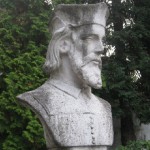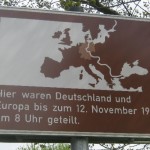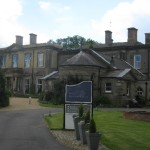
I spent Monday 27th April-Friday 1st May, attending the annual Intercontinental Church Society (ICS) Chaplains Conference, which this year took place at the Mennorode Conference Centre, Elspeet, in the Netherlands. As I mentioned in my first post of 2015, this has resulted in an addition to the number of countries I have visited, having never previously set foot in the Netherlands until two weeks ago today.
To get to the Conference Centre involved a drive from the Czech Republic, right across Germany, which eventually took ten hours – from 07.00 when I left Prague, until 17.00 when I finally got to Elspeet. This was somewhat longer than I had anticipated, almost entirely due to Baustellen/road works on the German Autobahn and associated Stau/traffic jams. Signs telling me whilst stuck in slow moving or stationary traffic that, ‘Wir bauen für Sie’, engendered the same frustration that I used to feel seeing signs for the ‘Cones hotline’, when stuck on British motorways in past years 🙁
My journey took me first through the former East Germany, passing around Dresden, Leipzig, Halle and Magdeburg. Heading westwards on Autobahn 2 towards Hannover, I crossed from the Bundesland of Sachsen Anhalt, into the Bundesland of Niedersachsen and in doing so, crossed into the former West Germany. Between 1st July 1945 and 30th June 1990, this was the location of Border Checkpoint Helmstedt-Marienborn, controlling traffic and goods passing between West Germany and West Berlin. It was also the busiest of the small number of crossing points on the former inner German border because it provided the shortest route across East Germany, (only 170 km), between West Germany and West Berlin.
These days, traffic passes at considerable speed where once vehicles could be held up for several hours. There is a sign that indicates that this is where the former inner German border used to be, together with a disused watchtower overlooking the site. But twenty-five years after German reunification, I could still notice visual differences as I passed from East to West.
I drove on around Hannover and Osnabruck, finally entering the Netherlands near the Dutch town of Hengelo. That evening, I told several of my fellow Chaplains that it was my first time in the country. ‘What were my first impressions?’ I was asked. ‘It’s rather flat’, was my reply. The other immediate observation I made is that Dutch petrol is more expensive than the German variety, something I made note of for my return journey at the end of the conference.
As in previous years, the conference struck a nice balance between prayer, worship and teaching with some free time each afternoon, to explore the immediate surrounding area. The highlight for me were three Bible expositions on the Jacob narrative from the Book of Genesis, led by my colleague, Rev’d Dr Paul Vrolijk, currently Chaplain in Aquitaine, France, but about to become Senior Chaplain in Brussels this coming summer. His talks were based on his doctoral thesis and gave great insight into the Hebrew literary structure of the narrative & the wider structure of Genesis. He also brought out some of the many plays on words in the Hebrew text, which are inevitably ‘lost in translation’.
As so often with conferences of this nature, some of the most valuable time was spent talking informally with colleagues over coffee or on occasions, something a little stronger 🙂 , such as the excellent but rather strong Belgian beer that was on tap at the Conference Centre bar. All of us work in somewhat isolated situations, I in a very isolated one, with rarely any opportunity to meet with each other except at this annual gathering.

Deciding on Thursday afternoon, that I did want to see a little more of the Netherlands than the inside of a very comfortable and well-equipped conference centre, I set off in the car, to visit the nearby historic Hanseatic city of Deventer. I hope the photographs that follow will give a flavour of what I saw during my all too-brief visit.

It being the Netherlands, there were inevitably bicycles everywhere!

The Mountain Church dedicated to St Nicholas/Bergkerk Sint-Nicolaas. It is no doubt called the Mountain Church because it is situated at the top of a small hill, which is a mountain by Dutch standards 😉 Dating from around 1200, it is now used as a gallery and concert venue.

Beautiful Dutch brick architecture. The building next door was being completely renovated, hence the crane.

St Libuinus Church/Lebuïnuskerk is the most famous city landmark

Originally Roman Catholic, it was taken over by the Calvinists in 1580 who completely eliminated the interior decoration. This is how the interior looks now.

However, this fresco showing Jesus carrying his cross, has survived situated in the Church porch.




Ricky, your annual posts about your attendance at the chaplains’ conference and your diocesan synod always makes me reflect on how very different life is in the Diocese of Europe from other dioceses. In my diocese I used to grumble at having to make so many 190 mile round trips to Bangor to attend meetings! 🙂 I’m glad you find all the travel so worthwhile and certainly I enjoy your photographs of the places you visit.
One minor correction: the German word which translates as Saxony has an S in it, therefore Sachsen Anhalt and Niedersachsen.
Both the ICS Chaplains Conference & the Eastern Archdeaconry Synod (not Diocesan Synod!), only happen once each year, so it is only two long journeys every 12 months. And as I did in 2014 when the ICS Conference was in the UK, I can often add in some annual leave, making the long journey even more worthwhile. Glad you enjoyed the photographs of Deventer. I just wish I’d had more time to explore.
Thank you for pointing out my German spelling errors which I’ve now corrected. One minor correction to your comment: just as you are part of the Church in (not of) Wales, so my diocese is the Diocese in (not of) Europe 😉
I stand corrected. 🙂
Hi Ricky,
Thank you for a very interesting account of yet another transit of a large part of Europe. You certainly get to see many ‘out of the way’ places and have the great knack of making them accessible to all of us by your ability to describe your surroundings and feelings concisely. I’m sure it is a great comfort to you to take part in these conferences and have the chance to interact with your colleagues, despite the distances involved in travelling there. It occurs to me that your visit to Deventer is somehow apt in connection with current plans for the UK to vote on membership of the EU. When you consider the Hanseatic League was in many ways the forerunner of the EEC/EC/EU albeit on a smaller geographic and political scale there is a sense of deja vue. I wonder is anything in human history is ever truly new or unique, it is usually a case of here we go again in some shape or other. Thank you as always Ricky.
Hi Sean,
Thank you as always, for visiting & commenting here. I’m glad you enjoyed the post. I very much liked your suggestion that the Hanseatic League could be seen as a forerunner of the EU. Regarding whether, ‘anything in human history is ever truly new or unique’, I’m reminded of a quotation attributed to Hegel. ‘History teaches, that history teaches us, nothing!’
Hi Ricky,
Very wise man Hegel! I hadn’t heard that quote before,thank you for enlightening me.
Happy to enlighten you, Sean!